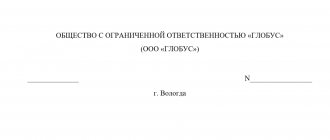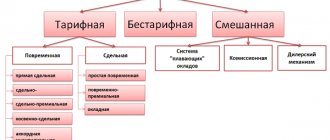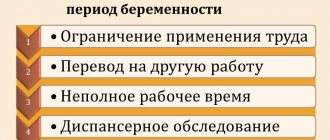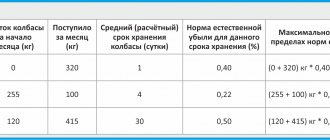Basic tasks of labor standards
Labor standards (LT) are introduced at the enterprise to solve the following problems:
- Drawing up a work plan.
- Proper organization of work activities.
- Proper distribution of responsibilities between employees.
- Evaluation of the work of specialists for subsequent bonuses.
- Development of a reasonable standard of labor costs for each area of activity.
- Analyzes possible ways to increase productivity.
- Reducing the cost of goods.
- Optimization of the use of production resources.
Labor standardization solves a number of problems. The use of standards in an enterprise makes it possible to increase the efficiency of personnel activities.
Why is labor regulation necessary?
Labor standards are needed primarily in order to calculate production costs associated with paying wages to employees of an enterprise in relation to a specific period of time. Also, labor standardization is intended to ensure the calculation of planned indicators of labor intensity in relation to the production of certain goods (parts, spare parts, assemblies).
The corresponding mechanism can be used when calculating the optimal number of personnel at the enterprise as a whole or in any of its structural divisions. The system of labor standards can be used if it is necessary to make an objective assessment of the quality of work of personnel in the company, to determine the criteria for awarding bonuses to employees in certain positions. The mechanism under consideration is useful from the point of view of analyzing the effectiveness of introducing new technologies in production and determining the optimal number of fixed assets of an enterprise.
Types of labor standards
There are NT approved at the state level. However, the enterprise is recommended to develop its own standards based on official values. They must meet the individual needs of the company. For example, an enterprise determines the volume of products that must be produced in a given period of time.
Labor standards are divided into types depending on the method of their determination:
- Justified using the scientific method.
- Obtained experimentally and statistically.
They are also divided into types depending on the content:
- Time indicators.
- Production indicators.
- Number values.
- Service indicators.
- Controllability values.
Let's consider the basic labor standards, as well as their features.
Time standards
Working hours are approved taking into account the worker’s specialty, his training, and working conditions. The rate is calculated in man-hours. It is determined by this formula:
NVR = Tpz + Top + Brake + Ttl + Tt
The formula uses the following values:
- Tpz is an indicator of time.
- Tpz – deadlines for completing the task.
- Top – operational time.
- Torm is the time required to service a workplace.
- Ttl is the period needed for rest.
- Тт – time periods allocated for technological breaks.
The formula allows you to determine the exact time needed to solve a particular problem. Based on the considered indicator, you can find out how quickly the employee completed the work. For analysis, you need to have a starting point, which is the production rate.
Labor standardization methods
Let us consider by what methods labor rationing is carried out. There are two main types: analytical and summary. The first include methods based on a preliminary study of the production resources of a particular workplace, as well as on determining the costs associated with carrying out a particular operation on the factory line.
Analytical methods are usually built within the framework of a sequential algorithm. First, the production process is divided into several stages. The factors that influence the duration of each task are then recorded. Next, the optimal composition of operations characteristic of a particular stage is designed. Next, the time costs for work within each section of the production chain are calculated, after which the corresponding indicators are summed up.
Analytical methods come in two main varieties. First, it is a calculation that assumes that time costs will be calculated on the basis of existing, scientifically sound concepts (or standards). Secondly, this is a study that involves direct measurements, the result of which may differ from data ever recorded before in production. It can be noted that the calculation method in any case appears on the basis of research.
When using summary methods, it is not expected to analyze the production process and calculate certain rational parameters. The engineer's main tool here is statistics. It collects data obtained from certain areas of production, which can then become the basis for subsequent analysis at the level of full-fledged research. Therefore, from the point of view of business practice, methods of the first type—analytical—are, as a rule, more useful. They may involve various tools.
For example, this could be timing - determining the duration of certain production operations over time. It is also possible to use photography to record the visual state of factory lines at certain stages of operations.
Production rate
The output indicator is the volume of activity required to be performed in a certain period of time (shift, hour). The volume of work can be understood as the numerical value of the product that must be manufactured. When making calculations, all factors must be taken into account: the employee’s specialty, his training, working conditions. There are many formulas for determining production standards. Let's look at the standard one:
Nvyr = Tsm / Nvr
The formula uses the following values:
- Nvyp is the production norm.
- Tsm – time reserve.
- Nvr is an indicator of time.
NV is a purely individual indicator determined by the company independently.
Standard of service
The maintenance rate is the volume of objects that need to be serviced within a certain time. For example, an enterprise has a certain amount of equipment. It needs adjustment, which is carried out by an adjuster throughout the shift. A narrower concept of a service norm is a controllability norm. It is used in relation to the work of managers. The service rate is determined by the following formula:
Nob = Td / 1rev
The formula uses the following values:
- Nob – standard of service.
- Тд – time reserve for work.
- 1rev – time required to service one object.
These are the basic standards that are needed in the activities of any enterprise.
Other labor standards
Let's look at other labor standards:
- Number indicator. Allows you to determine the number of employees needed to perform the work within the existing conditions.
- Controllability indicator. Refers to the management of the enterprise. This is the optimal number of employees subordinate to one manager.
Norms are divided into types depending on the form of enlargement:
- Differentiated. They represent time standards determined on the basis of differentiated standards for various stages of the task. Norms are established regarding stages and sets of actions. Differentiated norms are considered the most accurate.
- Enlarged norms. These are standard standards for time, service, and number of employees. The difference is that they are approved in relation to one product, technological process, or a given amount of work.
- Complex. These are time or production standards that are established in relation to a larger meter relating to a set of interrelated actions. For example, the norm can be set relative to 1 square. meter of material. This value is used in various industries: construction, logging, oil refining.
The standards are classified depending on the mandatory use:
- United. They represent time standards for completing work. This takes into account the amount of work, the number of employees, and the time allocated to solve the problem. Usually a period of time is taken in shifts. The specificity of this norm is that it is established in advance for all companies. This standard is relevant for work, the conditions of which are approximately the same at all enterprises. The use of the norm in question allows us to form a unified system regarding rationing and remuneration.
- Typical. Determined based on the generated standard process. When calculating, the standard time and operating mode of the equipment are taken into account. Standard standards are relevant within the framework of mass production. They are used based on a typed workflow. In other cases, the values should not be used, as they will not be accurate.
By area of use, inter-industry, sectoral, and local indicators are distinguished. Norms are also classified depending on their validity period:
- Conditionally permanent. Used on an ongoing basis within the technical specifications.
- Temporary. Used for a short time (3-6 months). Relevant when introducing new products and new technologies.
- One-time. Apply to one order.
- Seasonal. Relevant for seasonal work.
There are suitable standards for almost every specific type of work.
Subject and meaning of the course
The term “labor rationing” is used in several meanings:
firstly, as a process of determining labor standards;
secondly, as a type of practical human activity, i.e. as a profession;
thirdly, as a function of a specific structural unit of the enterprise (labor standardization bureau) or official (standardization officer);
fourthly, as a branch of scientific knowledge, a relatively autonomous part of the science of labor organization;
fifthly, as a training course that is taught in secondary specialized and higher educational institutions.
An important condition for ensuring a certain production efficiency is the optimization of the use of all types of resources involved for this: human labor, raw materials, fuel and energy, tools and equipment, etc. One of the ways to optimize the use of production resources is rationing, i.e. a reasonable determination of the amount of specific resources that is necessary to carry out economically efficient production at the achieved level of development of the production forces of society. This refers to a certain objective measure of the use of resources per unit of product produced. Any excess use of them will instantly increase the cost of production and reduce the profit of the enterprise. Unjustified saving of resources is also unprofitable, because it leads to a deterioration in product quality, which in market conditions for an enterprise can result in losses greater than what was saved.
The above fully applies to living labor. Extra people in production mean low labor productivity and high production costs due to unjustified payments of money in the form of wages. A smaller number of personnel compared to objective needs provides some savings in wages, but leads to disproportions between structural divisions and disruption of the production rhythm with all the ensuing consequences.
Labor rationing as the process of determining the objectively necessary expenditure of working time in all spheres of human activity is one of the most important components of the social organization of labor. The essence of labor rationing is to establish the optimal cost of living labor to perform certain work under normal organization and intensity of labor.
The specific form of expressing the measure of labor is its norm, which is determined in the process of rationing. Each justified standard, designed for specific organizational and technical conditions of production, must at the same time be a socially necessary measure of labor. To ensure exactly this level of justification for labor standards, the standardization process should include:
a thorough study of the organizational and technical conditions for performing each specific work subject to standardization;
organizational and technological design of the work process;
determination of labor standards based on organizational and technological regulations;
providing the necessary assistance to performers as they master new labor processes and norms.
Labor regulation is also an integral part (function) of production management. The allocation of rationing to a separate function of the enterprise management apparatus is a natural consequence of the deepening social division of labor. All costs for the implementation of this important function are repaid many times over by the savings in living labor that the corresponding functional services of the enterprise provide daily through their activities.
The importance of labor standardization for an enterprise is expressed in the fact that it:
firstly, it helps to establish the objectively necessary costs of living labor to perform a specific job;
secondly, it is the basis for most planning and economic calculations at an enterprise, both current and future.
Based on labor cost standards, the economic efficiency of scientific, technical and organizational innovations is also calculated.
In a market economy, when an enterprise becomes economically independent, and competition among commodity producers brings issues of survival to the forefront, labor rationing takes on special importance as an effective way to reduce the cost of living labor, save money spent on labor, reduce production costs and increase its competitiveness. Together with the tariff system, labor rationing is an effective means of positive labor motivation aimed at enhancing the creative activity of workers.
The subject of labor rationing is the duration of labor processes over time, and the object can be any purposeful human activity, both physical and mental, i.e. the labor process in its concrete and specific manifestation.
Thus, the main tasks of labor standardization are to develop methods for analyzing working time costs, rationalizing labor processes, establishing labor standards and adjusting them when production conditions change.
The course “Labor Standardization” includes:
concepts related to the principles of standardization, elements of the production process, the structure of labor standards and methods of their scientific justification;
methods for studying the cost of working time and preparing initial data for standardization, the procedure for choosing optimal options for organizing and labor standards in various production conditions;
organization of work on labor standardization, recording the implementation of standards, a system for their revision, and analysis of the state of labor standardization.
When studying any course, it is necessary to consider its connection with other disciplines. For the course “Labor Standards” this is especially important, since labor standards are a multidimensional category, and its value depends on a complex of technical, economic, psychophysiological and other factors. Since the establishment of labor standards takes into account the systems of organization of production, labor and management, the standardization course is interconnected with economic disciplines that study the economics of the industry, the organization and planning of enterprises, the organization of labor, and labor economics. For effective management of labor standardization, the correct formulation of accounting for working time costs and analysis of the quality of standards are of great importance, which indicates the relationship of the course with the disciplines studying accounting and economic analysis.
Labor rationing is more closely interconnected with technical disciplines than any other economic science, since its technical aspects are determined by the direct dependence of working time costs on the characteristics of the technological process and equipment operating modes, and practical activity is unthinkable without deep knowledge in the field of technology and equipment of the corresponding production. When studying the course, knowledge of the basics of physiology, psychology and sociology of labor, ergonomics, labor protection and safety, and industrial sanitation is required. The recommendations of these sciences are used in determining the required time for rest during a work shift, choosing the speed of labor movements, the pace of work, distributing functions between members of production teams, rationing their numbers, and designing work and rest regimes.
Work on labor standards is supported by labor law. The course “Labor Standards” is also associated with disciplines that study automated systems for preparation, planning, regulation and production accounting.
(major course!)
Knowledge of the course “Labor Standardization” is a necessary condition for successful activities in the field of planning labor productivity and the number of employees, organizing wages and managing labor resources.
Regulatory acts
Labor standards are regulated by relevant provisions in legislation. In particular, these are:
- Section of the Labor Code of the Russian Federation “Labour standardization”.
- Resolution “On the establishment of NT” dated November 11, 2002 No. 804.
- Relevant recommendations of the State Construction Committee of the Russian Federation.
- Order of the country's Ministry of Construction for individual employees.
There are both general laws regarding labor standards at all enterprises, and rules regarding individual industries.
IMPORTANT! The accuracy of the labor standard approved at the enterprise depends on which specific standard is chosen. This indicator is determined based on the characteristics characteristic of a particular company: the severity of labor, available equipment, the number of employees in the enterprise, etc.
Labor standardization in legal acts
We noted above that labor organization standards, having appeared in the studies of individual talented engineers, gradually flowed to the level of official sources of law. This trend can be considered fully relevant for the Russian legal system. The main legislative source of the Russian Federation in the field of labor relations, the Labor Code, contains an entire chapter that talks about labor standardization. Its number is 22, it contains 5 articles. Let's consider the main provisions they contain.
Article 159 of the Labor Code of the Russian Federation determines that the established labor standards for workers at an enterprise are the responsibility of not only the employer, but also the state. This part of the Code also states that the application of appropriate standardization systems must take into account the opinion of the trade union body or be consistent with the terms of the collective labor agreement.
Article 160 talks about what labor standards actually are and gives their definition. Let's bring him. By labor standards, the legislator understands indicators related to output, number, as well as time and other criteria that are established in relation to the available level of technology and organization of production processes. The parameters in question may be revised as new technical solutions are introduced or in the process of carrying out work at the enterprise to optimize personnel productivity.
Article 161 talks about how labor standards should be developed. As for homogeneous work, the legislator recommends establishing standard criteria for them. Which may be of an industry or professional nature. In this case, standard labor standards must be developed and approved in accordance with the provisions of the Government of the Russian Federation.
Article 162 of the Labor Code of the Russian Federation contains provisions regarding the introduction, adjustment, and revision of the criteria in question. The Code states that local sources of standards at the enterprise must be adopted taking into account the opinion of the trade union body. The law also contains a provision requiring the employing company to warn employees that new types of labor standards will be introduced at least 2 months before their approval.
Article 163 of the Labor Code of the Russian Federation states that the enterprise is obliged to provide comfortable conditions for employees to perform their functions so that the required indicators are achieved. In particular, the employer must keep various premises, equipment, and structures in good condition. Workers must be provided with the necessary documentation for instruments and machines, and access to high-quality materials and tools.










